14 Ways to Get Amazon Product Reviews in 2024

Updated 2024 with up-to-date tactics and strategies.
As we all know, reviews are critical to a product's success on Amazon. Ever since, Amazon removed incentivized reviews, getting reviews has been harder and harder. However, there are some easy sure-fire ways to get Amazon product reviews – some that are completely white-hat, and some not so white-hat.
In this post, we'll discuss the current state of affairs for Amazon product reviews and how to get those critical first reviews.
How to Get Amazon Product Reviews and Ratings
This article will describe how to get Ratings which include both text reviews and simple star ratings of your product. Your overall rating is what contributes to the star rating of a product, which is what we all care about.
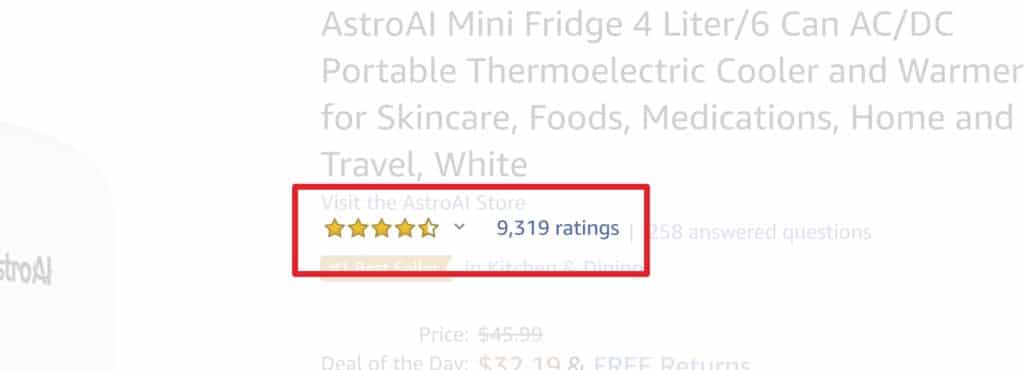
In 2020, Amazon transitioned Reviews to Ratings. The difference is that customers can now simply leave a star rating without leaving a text review.
It is far easier for a customer to leave a star rating than a written Amazon product review. The consequence has been that is now easier to get ratings on Amazon. Ratings also tend to skew higher than reviews.
How Amazon Calculates Product Ratings
Ever since Amazon removed incentivized reviews and introduced verified and non-verified reviews, how Amazon calculates a product's rating has become increasingly complex. All ratings and reviews are not weighted equally.
Amazon uses a complex weighted-average algorithm when calculating the average rating of a product. A product with just one five-star review could potentially have a rating of anywhere from 0-5 stars.
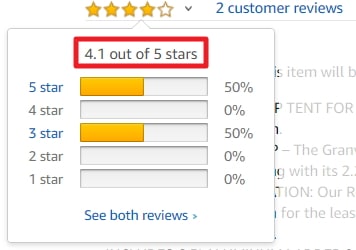
Amazon does not reveal the factors considered in this algorithm but it's commonly accepted the following variables are important:
- Review age
- Reviewer profile (number of reviews, the average rating of reviews left, etc.)
- Length of review
- Number of helpful votes
- Verified or non-verified
- Rating vs written review
- Deviation from mean rating
Essentially, a recent long Amazon product review with a number of helpful votes written by a reviewer with a strong reviewer profile will likely show up near the top of your reviews and will also weigh your overall rating more heavily.
Amazon White Hat Review Strategy
Here's a solid white hat review strategy for getting Amazon product reviews and ratings:
#1Amazon Vine
In December 2019, Amazon rolled out the Vine program to all sellers.
To use Vine you enroll your product via the Advertising menu within Seller Central. You then give your product away to Vine Voices members (people with a history of providing insightful reviews). As of October 2021, it will cost $200 per product to enroll. Prior to October 2021, it was free but it's still a bargain compared to the $2500 it used to cost for Vendor Central clients. You can only enroll products with less than 30 reviews.
Vine is a great way to get some early reviews with one caveat: Vine reviews have been known to be more critical than average. 1-3 star reviews are not uncommon. Contrast this with the Early Reviewer program where most reviews typically are 4 or 5 stars.
Our article ‘What is Amazon Vine and How to Use it in 2023‘ provides further information on Amazon Vine that you may find helpful.
#2Use the Request a Review Button
As previously mentioned, Amazon rolled out the Request a Review button in 2019. In our testing, we've found this button results in about a 10% to 20% increase in the rate of reviews. Increasing the probability that existing customers leave a review is the most important thing that you can do to increase your number of reviews.
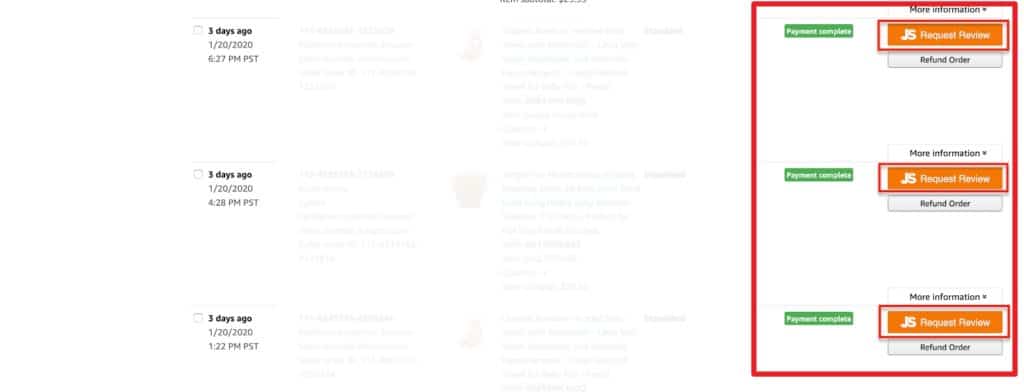
Here are some more details about what orders you can use this button on and what exactly happens when it's pressed:
- Must be used on orders within 4-30 days of an order being delivered
- Product rating requests and seller feedback requests will be sent in the same email
- Message cannot be customized
- Using it does not disallow you from requesting a review separately
You can manually click this button on your Manage Orders page within Seller Central. However, the easiest way by far is to use some tool to automate this such as Jungle Scout's Chrome extension

We dive deeper into some common questions that businesses may have regarding customer communication in our Unofficial Guide to Amazon's TOS.
#3Use Product Inserts
Product inserts can be useful when reminding customers to leave an Amazon product review although you must be careful not to provide any if/then statements in the insert verbiage, for example, “If you leave us a review then we'll give you a lifetime extended warranty”.
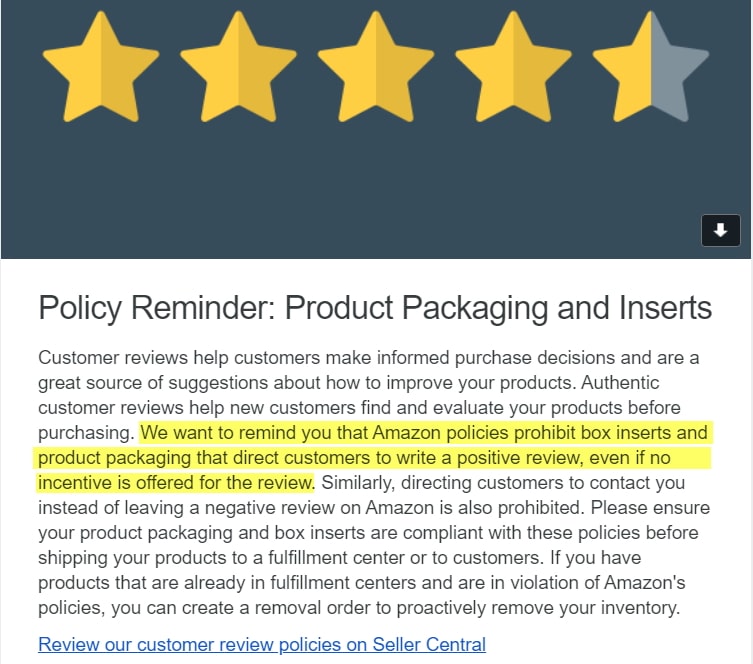
One effective and relatively risk-free way to use inserts is to ask customers to register their product for an extended warranty (or something similar) to get their email. Afterwards, you can enter them in an email auto-responder series to remind them to leave a review.
Amazon sends an ominous email to sellers reminding them not to use inserts to ask for positive reviews. Reminding the customer to leave a review is still OK, you just can't ask them to leave a positive review.
#4Product Giveaways and Discounted Products
By using steep discounts, you can get more sales for your products and increase the likelihood of more Amazon product reviews. I price all of our prices with a 25% discount when launching them to get stronger immediate sales.
There are also discount and rebate clubs that push the boundaries of white hat tactics but are still technically TOS compliant as of this writing. RebateKey is one of the most popular of these services. These services often are more aimed at getting sellers full price credit for sales than reviews per se but a high percentage of purchasers do in fact leave reviews.
Related Reading: How to Use Amazon Giveaways to Increase Sales
#5Launch New Products to an Email List (VIP Club)
Hopefully, you've been building your off-Amazon email list. If you have an email list, then when you launch new products do not send them links to your website to purchase, instead send them directly to your Amazon product detail page on Amazon. This accomplishes two things:
- You get vital initial sales velocity for your products
- Your email list is more likely to produce satisfied customers who will subsequently leave Amazon product reviews
Sales velocity is critical for Amazon. There are some who believe Amazon also rewards brands that produce sales on Amazon from outside of Amazon.
Second, your email list is likely to be an audience of people who like your product. Subsequently, they'll be more likely to leave positive reviews. You can also get into grey-hat strategies and in your email blast ask customers to email you after purchase and offer them some kind of refund via PayPal. You're not refunding them in return for a review – you're just offering a product discount. Of course, once they email you, you've gotten that critical customer engagement and it's easier to solicit reviews from them.
Here's a 62-Step Checklist on How to Launch a Private Label Product on Amazon.
How to Find Who Left an Amazon Product Review?
At this point, you may be wondering if there's a way to figure out who left you a review for a particular product. Amazon certainly does not make it easy to figure out who left a review. Clever services (often Chrome Extensions) for many years have used advanced techniques (specifically something called a profile ID) to help sellers determine the Order ID of who left a review. Amazon has closed these loopholes. As of now the only way to figure out who left a review is if the customer uses the same name on their product review as they use in their shipping address.
#6 Request Reviews from Customers Who Have Left Positive Seller Feedback
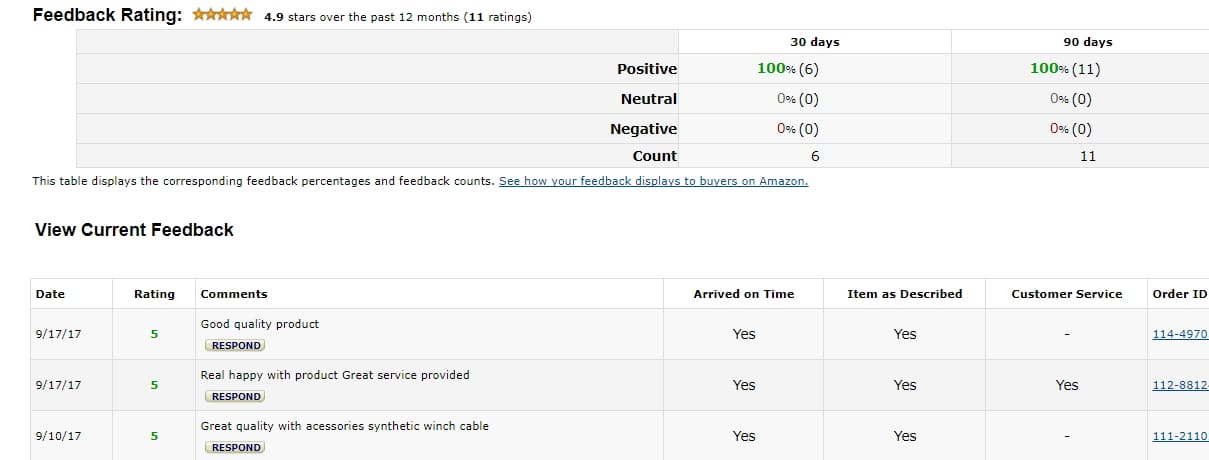
Most buyers on Amazon don't quite understand the difference between seller feedback and product reviews. Most of us have probably seen Amazon product reviews left in Seller Feedback at some point. It is essential to constantly review your seller feedback.
Proactively email all customers who have left positive seller feedback, especially those who left product reviews, and request them to leave product reviews. I even include an attachment like this with my emails explaining how exactly to leave product reviews. Only a small minority of buyers leave any feedback and those who have left seller feedback are more likely to leave product reviews.
#7Use Amazon to Contact Critical Reviewers
Up until recently, you were unable to contact customers who left a negative review as it was nearly impossible to find the buyer identity of a critical reviewer. In 2021 though, Amazon rolled out the ability to contact customers who have left a 3-star review or less.
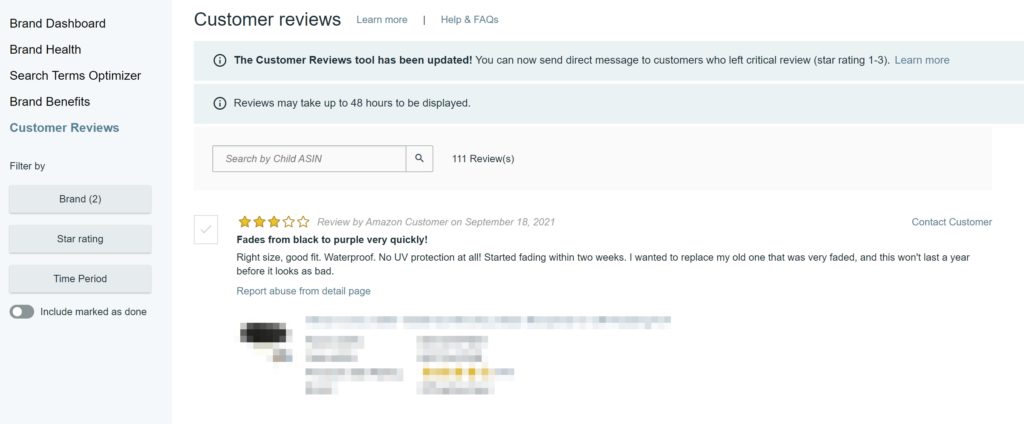
This feature works well to initiate a dialogue with customers who left critical reviews and hopefully make them happy and have them revise their reviews. There are some important notes about this buyer contact feature though:
- Amazon sends critical reviewers a canned message (and you can not send a custom message until the customer responds to the canned message
- You must be Brand Registered
- There is a contingency on the customer revising the review
This tactic won't get you any more reviews, but having customers change or delete negative reviews is arguably more impactful than anything else.
#8Great Packaging
In ecommerce, great product packaging leads customers to overlook product flaws and bad packaging makes them find flaws. Your product packaging is the first impression a customer will have of your product and often what customers will leave their review based on. You can see an example of one of the packaging for one of our previous brands below.
If you want to have a 4.5-star or 5-star product you need to spend a little bit more time and effort on your product packaging. This means no poly bags and no plain boxes. Use full-color boxes when possible. Include adequate use manuals (even for the simplest products) and other product inserts that give your product a polished feel.
#9Request Amazon Product Reviews from Customers You've Provided Customer Service To
If you engage in a conversation with people and provide great customer service, most people are happy to leave a great review regardless of the product. And I mean real engagement – not some Feedback Genius autoresponder. Engagement can include:
- Questions about a product before a purchase
- Technical support after a purchase
- Returns for a product that is simply no longer needed
- Making an unhappy customer happy
If you have a conversation with a customer and you ask them “can you leave a review?” most customers will happily oblige. The easiest reviews to get are from customers who ask a product question and then order. Check up on them in a week to make sure they got the product. AFTER they respond to your business email confirming they got the product then ask for a review.
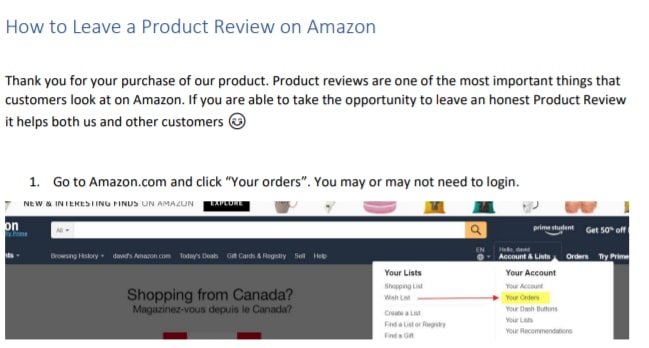
Grey & Black Hat Amazon Product Reviews Techniques
No article on getting Amazon product reviews would be complete without speaking about grey and black hat review techniques. I do not endorse these techniques at all (in fact, I would strongly suggest you avoid them altogether) but it's valuable to know what techniques sellers are using to get reviews in today's Amazon world.
#1Black Hat Tactic: Friend and Acquaintance Reviews
I suspect most sellers have been guilty of soliciting a review or two from a family member or friend. This is strictly against Amazon's TOS. Amazon is very good at detecting connections between reviewers and sellers (via shared shipping addresses, IP addresses, etc.) so sellers must be careful to avoid having these connections detected by Amazon if using these strategies. If used sparingly, the detection levels from Amazon are low and generally, if Amazon is suspicious of a small number of reviews, they will simply prevent them from being published.
Account Suspension Risk level: Low
#2Black Hat Tactic: Facebook Review Groups
On Facebook there exist A LOT of Review Groups where you give away your product to group members and refund them after they've posted a review. Here's an example of one Facebook review group. Search for “review group” on Facebook and you'll see tons more.
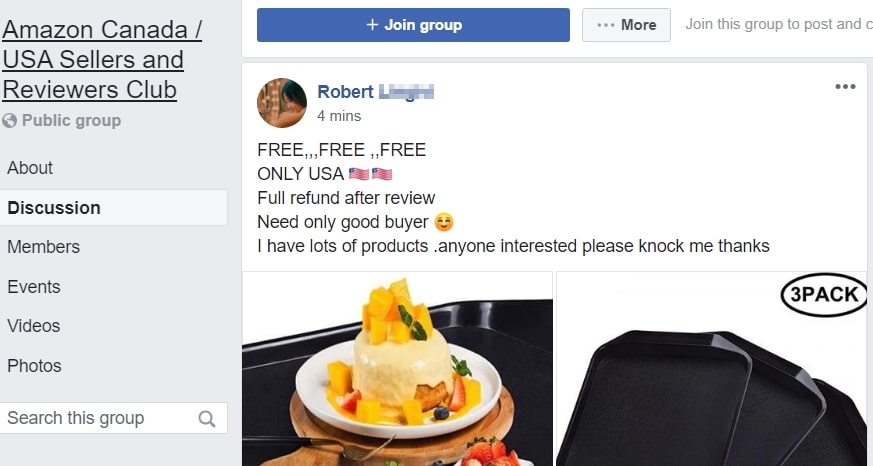
This is an explicit exchange of a refund for a review is one of Amazon's most suspendable offenses. Given that the entire exchange takes place off of Amazon it is difficult to track, however, all it takes is one customer messaging you through Amazon asking for their refund to immediately arouse significant suspicion from Amazon.
Account Suspension Risk Level: Medium
#3Black Hat Tactic: Using Email Append Services to Target/Contact Customers
Amazon famously does everything possible to keep sellers from accessing customer information. They hide email addresses and phone numbers. Email appending services take Amazon shipping information and match it against Big Data databases to obtain a customer’s email address and/or phone number. Some services claim a 40% success rate but most are well below this.

It's a bad idea to contact these customers directly once you get their email but these services can be used effectively to remarket to customers on Facebook/Google/etc. with minimal chances of being caught from Amazon.
Account Suspension Risk Level: Medium
#4Black Hat Tactic: Using Zombie Accounts to Get Fake Reviews (Brushing)
Amazon has a serious issue, especially among Chinese sellers, with fake reviews. This is done on a LARGE scale to accumulate dozens or hundreds of fake reviews. Essentially these services use fake Amazon accounts to purchase a seller's products and then leave fake reviews. The sophistication of these services is mind-blowing. Prices range from $1-3 per review depending on the likelihood of these reviews being detected by Amazon.
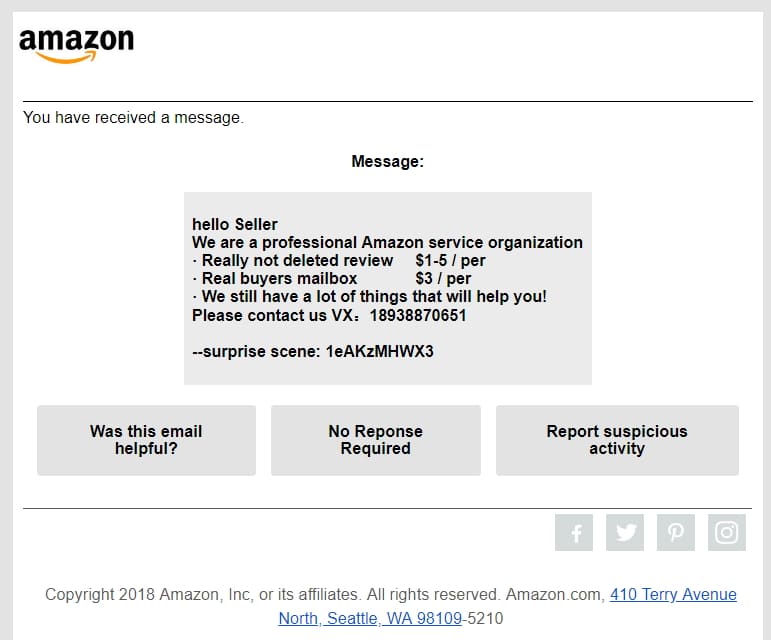
Amazon is playing a constant game of whack-a-mole to fight against these fake reviews and they are becoming increasingly better at detecting these fake reviews and suspending sellers permanently who use them. However, you don't need to dig to find a lot of sellers still using fake reviews with impunity.
Account Suspension Risk Level: Very High
#5Black Hat Tactic: Bribing Amazon China Employees to Delete Negative Reviews
Amazon also has a serious problem right now with employees accepting bribes from sellers to perform a number of nefarious tasks including deleting negative reviews. I am serious – this happens on a relatively large scale, especially among Chinese sellers. According to price sheets I have viewed from Chinese vendors, Amazon review deletion services charge around $300 per review deletion so it is not cheap.
Account Suspension Risk Level: Extremely High
Review Maintenance: Review Upvoting, Review Removal, etc.
There are a few other things you can do to improve your review profile, some white hat and some black hat.
Review Upvoting
Do you have a terrible 1-star review that is the first review being displayed? While you may not be able to remove it, you can upvote your top reviews to increase their visibility and decrease the visibility of the negative reviews.
Amazon normally displays the most helpful reviews at the top.
You can ask friends and family to upvote (re: mark as Helpful) a top review. There are also services that will upvote reviews for around $0.50-$1.00 per upvote. This is not TOS-compliant but also something Amazon does not appear to be monitored vigilantly.
Even more black hat, in 2019 there are reports that a large number of Abuse reports for a particular review will automatically trigger that review to be removed.
How to Have Negative Amazon Reviews Removed
Believe it or not, Amazon will actually remove negative reviews in certain circumstances.
The easiest reviews to get removed are ones that contain offensive language (swearing, racist terms, etc) or URLs.
However, recently, Amazon is also willing to remove reviews that are entirely fulfillment based for products fulfilled by Amazon. If requesting this type of removal simply open a case within Seller Central, give a link to the review and clearly state the reason that you are requesting removal. Amazon loathes to remove reviews but it's worth trying, even with a low success rate.
There are a number of services now that will automate non-compliant review removal for you, such as uglyfeedback.com, but they're essentially using bots to scan reviews and look for reviews that violate Amazon's terms of service and ask them to remove them.
Conclusion
The landscape for obtaining reviews on Amazon has completely changed in the last year. Launching products has gotten considerably harder but this can actually be a good thing for many sellers as it keeps out a significant portion of the competition.
What is your review strategy for launching a product? Do you have any tactics not mentioned here? Please share in the comments below.







This is abrlgreat article, guide and it well explained with detailed information.
The article emphasizes the significance of Amazon product reviews and the transition to star ratings. It discusses Amazon’s complex algorithm for rating calculation, highlighting key factors like review age, reviewer profile, and the impact of ratings. However, it falls short in delivering up-to-date strategies for obtaining reviews, leaving a gap in practical guidance for sellers. It would benefit from more in-depth information on the white-hat and not-so-white-hat methods and an emphasis on ethical customer engagement to build trust.
Great tips! This blog provides valuable insights on getting Amazon product reviews in 2023. I’ll definitely try out these strategies for my business. Thanks!
hi – just read this article. I’m a new amazon seller, and wanted to get your thoughts about this situation:
A customer left us a negative view on a chair that required assembly. The chair itself is fine but it was evident that she didn’t follow the assembly instructions, and consequently the chair broke.
She left us an unverified 1 star review as she didn’t purchase the product directly from us. Seems it was her nephew who purchased it, so we can’t directly contact her. We did reach out to the nephew but haven’t heard back.
Since she disclosed her full name on the review , we were able to find her on FB & on linkedin – we’ve had a debate internally whether we should reach out to her and explain the situation,(i.e. chair broke because she didn’t assemble it correctly) offer her a replacement /refund but are concerned that she may not take positively to this and may escalate to Amazon etc.
Would amazon penalize us on this – of course our email will be very courteous to her and we are not looking to pick a fight. Since our product is new we have only 9 reviews – all 8 were 5 star prior to this one, and we have noticed a dip in sales/conversions since this review came out :( We also feel that we are being unfairly penalized…if the product was indeed defective, it would be much easier for us to accept, but that’s not the case.
I appreciate the emphasis on continuous learning and staying updated with the latest trends in Amazon selling. Your blog is a great resource for sellers like us who are looking to stay ahead of the competition. Thank you for sharing your expertise!
Thank you! Glad to hear our content is helpful.
Amazing write up! Thanks for this submit
thanks a lot
Thanks for your information . i am read your article i am very impressive.
Glad to hear you liked it!
thanks for good sharing
Thank you!
Very helpful Information and Keep Sharing More.
Glad to hear it helped!
Thank you very much for share this great helpful information with us.
Glad it helped!
Thank you very much for share this great helpful information with us.
You’re welcome, we’re glad to hear this information was helpful to you.
Wonderful post! We’re linking to this terrific article
on our site. Keep up the great writing.
Best regards,
Balle Hessellund
That’s Great Information!
My boyfriend and I fell victim to a scam Amazon Choice product that bribes for fake reviews.
It is a “fat freezer” product that wraps around your stomach, and gives away free supplements in exchange for reviews. The product claims it takes months to work (because that’s how long coolsculpting takes), yet they spam auto-emails to customers immediately after purchase, to trick them to leave reviews in exchange for free supplements. It didn’t work for either of us, my boyfriend left a negative review… but it just gets buried. We reported them at that window at the top of the product listing, but I don’t think anyone even reads those.
It has a HUGE number of 5-Star reviews from people who pretty much admit they haven’t even used the product yet. We should have listened to our gut — too good to be true.
Amazon does nothing. Why would they? They still get their percentage of every sale.
Hi Dave,
Thank you for sharing such a wonderful article, it helps a lot.
I have clients selling products on Amazon, having good presence and brand name.
Recently we got few negative reviews, looks like competitors have planted those reviews. My client was frustrated and was advised by an expert to remove a listing and start a fresh one and get 30 reviews to make the listing stronger.
Where we completely disagree on a point to delete the listing and create new and getting those 30 free reviews as recently we got few reviews from a group, they reviewed our three items and just 8-10 reviews per item, after a month or so all reviews are removed by Amazon.
May I know how Amazon decides to remove a verified purchase review? Do you think getting quick reviews from such groups help to boost a listing?
I totally believe in white hat technics only, specially when a customer leaves feedback to seller, that’s the one would not mind to review a product.
Thank you!
No one knows the exact formula but in general an unnaturally high percentage of reviews given is a pretty big trigger.
Cool Article Dave! Hey I just want to clarify, I know this article is a bit old and there may be changes on how some of this stuff works but on White Hat Tactic #6: Aside from RebateKey, do you recommend any other services? I know a few like Snagshout and JumpSend.com (not a lot of reviews coming in from the latter). But to be honest the number of reviews coming in are kind of slow. I have seen quite a few ads from “https://www.massview.com/” recently, they look like they’re the most active ones that are geared towards more reviews. I would love to know your thoughts on them and any others that you may know!
There’s quite a few of these services out there now. I don’t have any experience with massview so can’t really say anything positive, negative, or otherwise about them.
Thanks for sharing such effective tactics that will work for getting Amazon reviews.
Besides learning how to get reviews, we have to learn how to deal with bad reviews too. Because a negative review lead people leave a business immediately. So, for responding to a foul review take enough time to create a peaceful and picked up response that may be seen by outsiders as a well-thought out response and not one written in rage. Be polite, simply apologize, offer the customer a solution.
Agreed.
Hi dave, hope all is well. I have a question. I recently launched my product on Amazon but only got one sell, I’m not sure what it is I am doing wrong to get more customers to purchase, I have good photos and have also paid for ads with no success, I am so confused and discouraged. I have yet to receive any reviews, can you please give me some tips or advice as to why the customers aren’t buying. Thanks
It’s hard to say without seeing the listing. You either have a traffic or a conversion problem. Check your business reports to figure out which one. Sounds like a conversion issue though which may mean you have a pricing issue.
You should read:
Amazon Rewards Fake Reviews – The Ebanel Case
https://communalnews.com/2019/04/02/amazon-rewards-fake-reviews-the-ebanel-case/
Interesting!
Awesome, thanks!
You’re welcome :)
Wow, this is a terrific list of ideas. Most of them appear to be geared toward Sellers rather than Vendors. Our brand is a vendor on Amazon, and we can probably only take advantage of a couple of the ideas above. If there are any additional ideas for Vendors, please let me know! Our competitors are mostly Sellers and certainly tap into these more proactive review generation mechanisms, which puts us at a disadvantage.
Being a vendor gives you a lot more flexibility with inserts et al because you can’t really get your account banned. Lots of Vendor Central customers who abuse this fact, for better or worse :-(
Getting reviews is getting harder and harder these days. Only a good customer serice will drive good reviews. But unfortunately there is no easy way to provide one for every client. Because most of them have opted out of receiving emails.
Yes agree, the inability to send any customer messaging makes things difficult.
Thank you for sharing these tactics!
Here’s what I’ve noticed:
– EBC reviews come too slow (can be even a month until you get your first, depending on your sales volume)
– the Seller Feedback Emails are effective, I recommend sending them manually and not via a 3P platform. Had serious open rate issues with those
– getting reviews from happy customers who reached out to you is the easiest as long as you know how to hook them and not be against the TOS
– the product inserts don’t work as well as they did so you have to find a very cool design or story behind the brand to get them to work
– ManyChat rules!! The QR codes they create for the flows can be placed directly on the product packaging.
– GA aren’t what they used to be, I wouldn’t rely much on them for reviews, maybe for drawing traffic to the listing or boosting the sales for the day
– Email lists are ideal and there’s a TON of things you can implement with them: contests, landing pages – they are the MVP.
As for the grey & black-hats:
– there are others that include appending another ASIN to your parent product to draw in its reviews or deleting asins that have the bad reviews
– friends and family don’t work anymore, they block the asin from receiving reviews OR they delete the review entirely. I recommend friends of friends or contacts that cannot be traced back directly to you
– email append still works BUT I’m pretty sure you’re only allowed to send 1 email per customer since they didn’t give their consent to receive direct emails from you. That and the GDPR is a bit tricky.
– those zombie ones are FREAKY. But explains why so many CN sellers rank so easily.
Thanks again for a very informative blog post!
Looking forward to many others
Wow Kassandra – this comment is incredible!! Thank you for your candid feedback from the trenches.
Hi Dave, do you have any more info on how to use manychat and appending services? Would be great if you dedicate a whole article to that strategy
For ManyChat we have a whole course on it in EcomCrew Premium(shameless plug for Premium). For the append services, I’ll add it to the consideration list for in the future :)
Hi, I have a question : I have a listing in food category and have been selling the product for 2 years so there is a database of my customers with name, address and “amazon email address” no their real ones. Now I am launching a new product in household category and I wonder if I can use those information to contact my customers to offer them a discount code for the new product. Is it against Amazon TOS? if not, what would be the best way or service for contacting them?
No, you can’t contact them (especially with Amazon tightening up post purchase communication). The only thing you could do is use an append service like zon pages and try to match emails…these services cost around $0.1 per email though.
nice post dave.
I’m beginning to think that all the review services are going to be less and less useful as more and more customers opt out of emails.
The way to go for USA FBA small sellers is to get the customer on your email list somehow. Direct contact and asking for a review after providing some kind of personal service is the way to go
Yes, it’s an effective way right now to get reviews.
Hi Dave,
I own a company that sells on Amazon and we are approaching 8 figures this year. I’m also part of a closely knit group of 200 7-8 figure sellers who are discuss everyday strategies and hacks to be at the top of our game. Of all groups I’ve ever been part of, this one has given me the most value in ways I can’t describe. 70 of us just went to Cancun together for a summit. We are always looking to bring smart talent into our group, especially someone who can add lots of value. In return, you obviously will get a wealth of info. Let me know if you’re interested. You might have heard of us, we are called MDS.
Hi David – Mike is an active member in MDS and I believe he just spoke there as well :)
It’s definitely getting tougher and tougher to get reviews. However, it’s still possible to get reasonable sales without a single review using a bit of ppc and good organic rank. I’ve proved this recently. There is some research pointing to the idea that good organic rank gives customers a feeling that the product is trustworthy – as algorithms don’t lie – even if there is a lack of valid social proof.
I’m finding that although I have a handful of 5 star ratings in seller feedback , getting an actual product review is hard. The flip side is the system is a bit fairer now that Amazon have cracked down. I’d rather have a handful of genuine reviews gathered over time than 50 unverified or suspect looking ones in the first few weeks.
One thing to consider doing is messaging those people who left seller feedback and ask them if they will consider leaving a product review as well :)
Hi Dave,
I listened to this podcast a month or so ago and have been thinking about messaging those who left seller feedback. I have not done this to date, mainly because I don’t want to impose on people (and perhaps some degreeof laziness). Well, in an effort to be more proactive, I’m going to start doing this, but I do have one question:
What subject should we select in the dropdown menu for these messages?
I think it is an important question, because you want the best chance the message gets through to the customer, but you also don’t want to violate any terms of service.
When I try to contact a customer who left a bad product review, I typically select “Order Information,” but I rarely ever hear back from customers, even when I offer a free replacement or no strings attached refund. I suspect many of these messages do not get through to customers.
Thanks for any insight you can provide,
Dave
Hi Dave – Feedback request is the most TOS compliant. “Additional information required” will always get through, even if they have asked not to receive marketing messages, but it’s not TOS compliant.
Great post Dave. I do not have any tactics for getting reviews to add but I do have a question that might make for a good post.
How do you deal with competitors who are clearly cheating the review system.
For example, I have a competitor who is selling a product for $9.99. I have purchased the product and it is very cheap and overall I believe it is low quality. At best I would give it a 3 star review.
They launched their product only a couple of months ago. They use every sneaky trick in the book including intentionally placing their product in the wrong category just to get “Best Seller” status etc from Amazon. But it is obvious that they are buying reviews by the simple fact that a large majority of their reviews have images attached to them and they have 5 customers who have left video reviews (a couple of which are pretty high quality for a customer review).
I have purchased their product and they do not use inserts to request any of this and they do not use Feedback Genius or anything similar to follow up. When I looked at the review profile for the 5 star reviews that they have it is quite obvious that the reviewers are in some sort of review group (who needs 15 fidget spinners, 10 pair of earbuds, 5 pair of headphones, etc over a month’s time… and all are 5 star)
To be even more annoying I believe they are paying these same reviewers to buy my product and leave 1 star reviews (I have not been able to make a connection besides I’m getting negative reviews from the same type of fake looking profiles buying high quantity of the same products and giving mostly 5 star reviews)
To me it is clear that they are cheating. If you ran into this issue with a competitor in your space would you do anything or let it go and focus on your own products? On one hand I want to report them but on the other hand I’ve heard so many people say it is a waste of time and that Amazon doesn’t do anything anyway. So far I have decided to focus on my products and my business and not worry about them. But it is more and more dificult when I see them beating me in ranking.
I thought that in time it should balance out if real customers buy their products in quantity and if they truly are poor quality that the true negative reviews would come through, and they have, but when they get a negative review all of a sudden they end up getting 10 5 star reviews. They are clearly playing games.
Thoughts?
Hey Joe,
Yeah, the underground review groups are highly annoying and a lot of other very nefarious things going on with reviews. I’ve never tried reporting a review cheater but I suspect it would be dealt with the same way Amazon deals with most complaints – with no action. I think faking reviews can win in the short term, but in the long term, the best products will have longevity. Probably the only real thing you can do in the short term is to try your hardest to solicit more reviews on your products.
I very much agree with your statement.
I am also deeply hurt.
I also sell products on Amazon and experience like you.
Now I redesigned my product line to ensure that others can’t sell the same product and then focus on my products and services.
Can we get contact in facebook?
Email address is my facebook account.